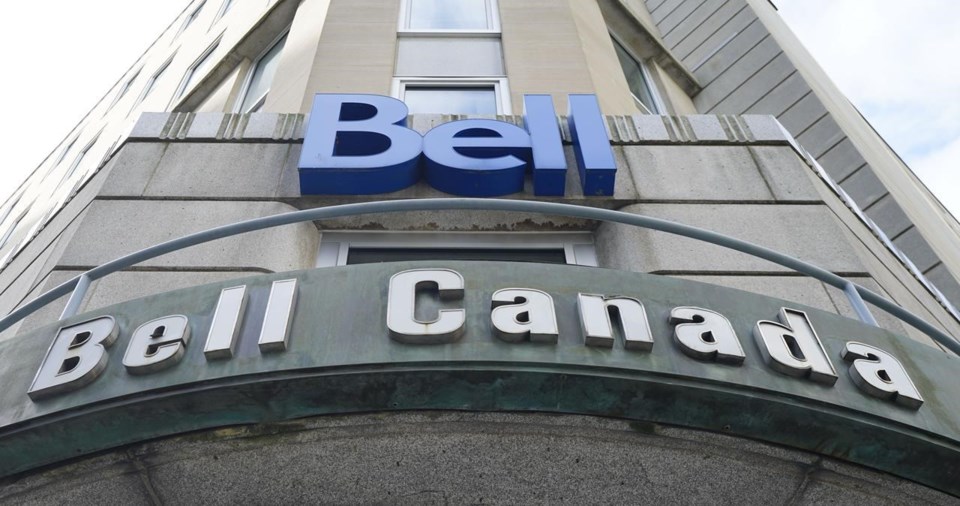Following a quarter in which it began cutting 1,300 positions, shuttered six radio stations and closed two foreign news bureaus, BCE Inc. says more cost restructuring could be in store in response to declining ad revenue and regulatory hurdles.
The Montreal-based telecommunications and media company reiterated the significance of those challenges on Thursday as it reported its second-quarter earnings and addressed analysts on a conference call.
Bell Media faces operating losses across its news divisions, "a prolonged advertising slump with no signs of immediate recovery," rising content production costs and "a more challenging regulatory environment that has not adapted to the new realities facing media," said chief financial officer Glen LeBlanc.
"This has required us to rightsize our operating cost structure and asset portfolio to align with the expected revenue potential of our media business," he said.
"Going forward, we will need to continue doing so in order to deliver for our shareholders in this unconstructive economic and regulatory environment."
President and CEO Mirko Bibic added that the company would continue monitoring regulatory and political developments that could impact Bell's bottom line.
"On the media front, more needs to be done by the CRTC faster. The ecosystem in sa���ʴ�ý is under severe stress and requires urgent government assistance," Bibic said.
"The regulatory playing field does not present an environment where the same rules apply to all."
In June, Bell Media asked the federal telecommunications regulator to waive local news and Canadian programming requirements for its television stations, saying those obligations are based on outdated market realities.
The application, which was filed the same day the company announced its layoffs, noted Bell Media's average annual news operating loss totalled $28.4 million between 2016 and 2019, a figure which jumped to $40 million last year as web giants scooped up the Canadian advertising market.
The parent company of Bell Media said Thursday its net earnings tumbled more than 39 per cent in its most recent quarter to $397 million or 37 cents per common share, compared with $654 million or 66 cents per common share a year ago. Adjusted net earnings totalled $722 million, or 79 cents per share, compared with $791 million, or 87 cents per share, a year prior.
Analysts on average had expected an adjusted profit of 80 cents per share for the period ended June 30, according to estimates compiled by financial markets data firm Refinitiv.
Operating revenue ticked up to $6.06 billion from $5.86 billion a year earlier.
RBC analyst Drew McReynolds said second-quarter results for the company were slightly better than forecast.
"On balance, we view the results as neutral to a modest positive for the shares at current levels," he said in an analyst note.
Bell attributed its increased costs to severance expenses, a higher interest rate environment and an obligation it had to repurchase at fair value the minority interest in one of its joint venture equity investments.
LeBlanc, who is retiring as chief financial officer at the end of the month, said cost savings realized through Bell's "very aggressive workforce reduction program" were not reflected in the second quarter results and would instead show in the back half of the year.
"That is another area of improvement in cost trajectory," he said, adding he believed the "transformation" of Bell's media division to become more digitally focused would bring some advertising revenue back.
"When it does return, we are going to have our assets positioned to capture a larger share of the marketplace than ever before. We will have used this time wisely to right the ship."
While Bell Media's advertising revenue was down nine per cent on a year-over-year basis in the quarter, Bibic said that was partially offset by digital revenue being up 20 per cent over last year, which now comprises one-third of total media revenue.
"We want to continue to pivot very strongly towards digital," Bibic said.
"We've been talking about this for about three years and I really like the momentum we're delivering and we're driving here on that strategy."
On the telecom side, the company added 111,282 net postpaid mobile phone subscribers, up 33.8 per cent from the same period last year and representing what Bell said was its best second quarter result for the metric in 18 years.
It said the increase was driven by 30.4 per cent higher gross subscriber activations, partly due to factors such as immigration growth, continued 5G and multiproduct bundling sales and effective promotions.
Attracting the business of newcomers has been a key priority for Bell, which earlier this year teamed up with Air sa���ʴ�ý to offer complimentary mobile SIM cards to international travellers arriving in the country on select flights.
It then partnered in June with the Institute for Canadian Citizenship to offer perks to users of its app, Canoo, which provides newcomers free access to cultural and outdoor experiences along with deals from brands.
Bibic said Bell is also serving new Canadians by expanding its retail presence in neighbourhoods with high immigrant populations and offering customer care and marketing in more languages. He said Bell does well in the "switcher market" — existing phone customers switching from one provider to another — but has room for improvement when it comes to newcomers.
"We need to do better and we will do better," he said.
Bell's monthly churn rate for postpaid mobile phone subscribers — a measure of those who cancelled their service — was 0.94 per cent, up from 0.75 per cent during its previous second quarter, reflecting more market activity and promotional offer intensity compared with last year.
Its wireless mobile phone average revenue per user was $59.16, down a cent from the second quarter of the prior year.
This report by The Canadian Press was first published Aug. 3, 2023.
Companies in this story: (TSX:BCE)
Sammy Hudes, The Canadian Press



